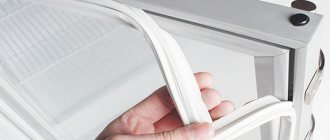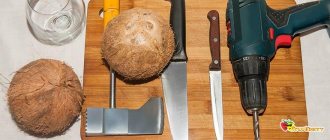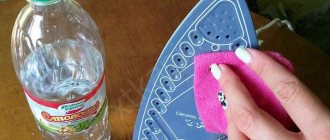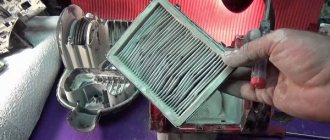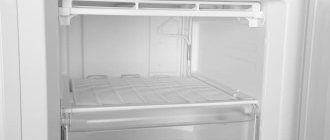If water begins to accumulate in the refrigerator compartment and an unpleasant odor appears, the user wonders how to clean the drainage hole in the refrigerator. The fluid drainage channel often becomes clogged and particles of food and dirt get into it. Proper cleaning helps keep equipment functioning properly.
Where is the drainage tube in the refrigerator and why is it needed?
During operation of the refrigerator, a natural process is the accumulation of drops on the far wall as a result of freezing.
When you turn off the refrigerator to defrost, the pieces of ice, of course, melt and the accumulated moisture flows into a special hole. It is called drainage. Thus, the drainage hole is a technical device located at the very bottom of the chamber. A rubber tube must be attached to it, which removes accumulated moisture into a special tray. Usually all the water accumulates above the engine. During the operation of the equipment, the water heats up and evaporates naturally.
Main function of the system
The main purpose of the drainage system, consisting of a technical hole, a drain hose and a receiving tray, is to remove moisture generated during the operation of the refrigerator:
- in household appliances that are equipped with a drip defrosting system, condensation forms on the rear wall of the chamber during operation of the compressor;
- moisture, provided the refrigerator is functioning normally, flows down a special groove into the drainage hole;
- a plastic tube is attached to the hole, through which the liquid flows into a reservoir located on the compressor;
- The electric motor heats up during operation, due to which condensate evaporates from the tray into the surrounding atmosphere.
Do you regularly clean your refrigerator drain? Not really
If there is water under the refrigerator, what should you do?
This may not seem funny to you, but the first thing you must do is make sure 100% that the water is flowing from under the refrigerator and not from other household appliances (gas water heater, boiler). If everything is in order, no one spilled water, and no other household appliances broke down, and the culprit of the flood is the refrigerator, then start checking:
If there is water everywhere: water constantly appears in the refrigerator and there is also a puddle on the floor, then there may be several reasons for this - let’s look at the most common cases.
Model with the No Frost function. Water is pouring out of the freezer compartment, and in the freezer itself there are huge blocks of ice and standing water.
A clogged drain hole is the most likely cause of this problem. Due to the blockage, excess moisture remains in the chamber, and when it accumulates in large quantities, it begins to freeze, turning into ice or a “fur coat.” To eliminate this problem, you need to make sure that the water in the freezer leaves the compartment on its own - for this you will need to clean the drainage drain, which is located inside the chamber under a plastic box. If you can easily wash the drain in the refrigerator compartment yourself, then in the freezer it is better to entrust this operation to a specialist.
2.The refrigerator has a “crying” type evaporator. Water flows out of the chamber from the front of the unit and stands under the trays at the bottom of the chamber.
As in the previous case, the drainage hole could become clogged. If this happens, then the water in the refrigerator does not flow out, due to the fact that the passage is blocked by a blockage of small crumbs and other food debris. The drain needs to be cleaned, and as we said above, this can be done without the help of a specialist. How to clean the drain in the refrigerator?
To do this, fill a small baby syringe with warm water (a syringe will also work) and point its spout into the drain - it is located on the back wall at the very bottom. If “douching” does not help, you can push through the blockage using an ordinary cotton swab or a thin cocktail tube - do this carefully so that the object does not fall inside the hole!
3.The food in the main chamber freezes - the lower shelves are particularly affected. There is water at the bottom of the chamber under the containers. There is a puddle under the refrigerator.
It is possible that the rubber seal on the door of your unit has become unusable. Warm air from the environment enters the compartment, and the compressor, trying to cool it, begins to freeze too intensely, which in turn provokes the growth of ice on the walls. Since heat enters the chamber all the time, this “fur coat” melts. The drainage drain does not have time to drain so much water, and the tray is not ready to accommodate this volume of water. As a result, water accumulates at the bottom of the electrical appliance, and some goes into the tray, but when it overflows, it pours directly onto the floor. The rubber band needs to be replaced.
4. You just delivered and installed the appliance, or you just had the refrigerator moved. These machinations ended with the refrigerator being full of water, and inside there was ice, and water, and the food was freezing over everything - and all this, despite the optimal temperature regime set in the refrigerator compartment.
Most likely, the refrigerator was installed incorrectly - it stands crooked, which is why the door does not fit tightly enough. Because of this, warm air gets inside the chamber and everything happens exactly the same as in the previous case. To solve the problem, you don’t need a technician - use the help of men and a level and install the electrical appliance evenly, in accordance with the requirements of the manual.
Timeliness is the main requirement for troubleshooting
From all that has been said above, we can conclude that there are no terrible reasons that can provoke a leak from the refrigerator, water in the refrigerator or freezer, and other unpleasant phenomena associated with water. Some cases can be solved even without the help of a specialist.
But the main thing is not to delay, no matter how stupid the failure turns out to be. Remember that water and electrical appliances are not the best friends, so either fix the problems yourself or call a professional.
Also, take note that water is a catalyst for corrosion processes, and if trickles of water often flow through your refrigerator, then sooner or later the body of your refrigerator will rust, and subsequently the capillary pipeline may also be damaged, sealing, refrigerant refilling, and ultimately repairs will be required refrigerator “will cost a pretty penny.” Therefore, timeliness is the main factor in eliminating any, even the most minor, breakdowns of your refrigerator.
What causes drainage to become clogged?
- Several reasons can cause a freezer to break down or become less efficient. The main problem is that food particles get into the drain on the back wall and the tube becomes clogged from the inside. This situation can occur when a liquid spills, crumbs get in, or the integrity of the packaging is compromised. At the entrance to the hole in the tube, deposits of salts and particles of products accumulate, which cannot increase in size due to contact with water and block the outlet hole.
- Another common mistake is overloading the storage room. Because of this, the products are placed close to each other and to the back wall. When the compressor is operating, particles of food and packaging can freeze to the rear wall, and during defrosting, flow into the drain hole into the tank and clog the hole.
- Incorrect installation of the unit. If the refrigerator is skewed in any plane, excess moisture collection is observed. This entails a violation of the tightness due to loose fitting of the doors, deformation of the water receiving tank is observed, and a displacement of the area where moisture enters the compressor. A large amount of condensate forms, which does not have time to evaporate, thickens, and clogs the drain. If the tube is not clogged, the liquid intake tank may overflow, causing water to overflow.
For normal operation of household appliances, it is necessary to keep the unit clean and carry out maintenance. Even with minimal knowledge and the availability of simple tools, it will be possible to avoid clogging and keep the equipment in good condition. The person will only need to be attentive and carefully follow the recommendations.
Why do you need to clean the drain hole?
Disruptions in the drainage system occur quite often. Usually the provoking factor is a clogged special tube.
This results from the ingestion of the following substances:
- Crumbs and food fragments. They fall from the shelves into a chute that runs along the back wall of the refrigerator.
- Residues of food that freeze to the evaporator wall. When thawing, these elements with melt water penetrate into the drainage system.
- Dust and grease. These elements accumulate on the walls of the refrigerator. This problem is caused by irregular maintenance. Such contaminants are washed into the drainage tube.
The first symptom of a clogged drain tube is water pooling under the vegetable compartment. If, after drying the refrigerator, liquid appears again, the cleaning procedure should be performed immediately.
If you do not do this in time, there is a risk of the following consequences:
- Constant presence of unpleasant odor in the refrigerator. Even regular cleaning, using filters and removing expired food does not help solve the problem.
- Reproduction of harmful microorganisms. A lot of pathogenic bacteria and fungi accumulate in the drainage system. They spread throughout the refrigerator and accumulate on food. Eating this food provokes infectious diseases and poisoning.
- Problems with condensate drainage. When liquid accumulates at the bottom, the lining suffers. There are cracks in the structure of the plastic surface. Through them, moisture gets onto the metal elements. Working parts suffer from corrosion, which leads to damage to the device. The most dangerous consequence is a short circuit, which causes a fire.
Causes of clogged drainage system
Several factors can cause the drainage device to stop working. The main ones:
- The drain becomes clogged with leftover food that is stored in the refrigerator without a bag.
- Accumulation of salt deposits and dirt due to improper care of exposed areas of the device.
- Freezing of food to the chamber wall. When thawing, remnants of frozen ice and food particles flow down the surface of the walls, ending up in the capillary drainage.
- Failure to comply with the requirements for installing a refrigerator. If the housing is constantly heated or tilted, the doors may become depressurized. Then an excess amount of moisture that does not have time to evaporate accumulates in the system.
Cleaning the drainage hole in the refrigerator is necessary when the first signs of blockage appear. The procedure is not difficult, so you can do it yourself.
What else can cause water to appear in the refrigerator?
If the drainage tube is clean, but water continues to accumulate at the bottom, then the reason for this may be improper installation of the refrigerator - if it is not level, then the doors may not close tightly, and heat begins to get inside. This leads to the compressor starting to work almost non-stop, trying to normalize the optimal temperature inside the refrigerator.
As a result, frost appears on the walls, after which it melts and water is formed. To get rid of this problem, just install the refrigerator on a flat surface.
Another reason for drainage failure in refrigerators with the No Frost system is not related to blockage. At the bottom of the drainage tube there is a valve, in some models a water seal. If air enters the tube through it, then over time it will transform into frost, developing into ice. It is he who prevents water from flowing into a special container. In some cases, the tube is short. The way to solve the problem is to lengthen it a little.
However, all of the above methods are good if the drain in the refrigerator compartment is clogged, but there is also drainage in the freezer itself. Only a specialist can clean a Samsung refrigerator in this place, as well as any other model, since this system is located very deep in the structure.
You can clean the drainage tube in the refrigerator in one very simple and affordable way. For this you will need a medical rubber bulb. Hot water is drawn into the bulb, and then the tip of the bulb is inserted into the drain hole and, using sharp pressure, water under pressure passes through the drainage tube, thereby flushing it and removing all blockages.
Thus, this procedure must be done several times, not forgetting to remove all dirty water from the tray above the compressor.
If possible, the drainage tube needs to be removed and washed, softening the debris that has clogged it with your fingers, if possible, but if this is not possible and it is located under the body, then you will have to tinker, often it gets clogged as if there is no hole there at all. We take it from our grandfathers at the market and buy a couple of meters of knitting, soft, galvanized wire, about one and a half millimeters in diameter, at home we rub the end with a sharpener, sandpaper, just a brick wall or a piece of stone (crushed stone) so that the end does not have sharp edges, so that damage the parts of the refrigerator and, moving and turning a little bit at a time, we clean the tube deeper and deeper, pour warm water into the hole, this will speed up the process, when the wire appears at the other end, bend it to the side with a lever and twist it, dragging it along the tube back and forth (length 2 meters that's enough), then pull it out and wind it up; you'll need it later, and rinse the refrigerator tube with a syringe or just pour some water on it.
In the refrigerator, the drainage hole and tube need to be cleaned regularly; if this is not done, then all sorts of crumbs, pieces of greens, food will get into the pipe through the hole, mucus will accumulate on the walls, clogging the tube and water from the walls of the refrigerator will flow down, under the boxes with vegetables.
You can first try to clean the hole in the drainage tube with a special brush that comes with the refrigerator. You can use a soft length of wire, then rinse the tube with warm water using an enema; under the pressure of the liquid, everything accumulated on the walls will go down into the tray.
Unfold the refrigerator, you will see a tray (bath) at the bottom and a drainage tube goes to it. Carefully check the outlet hole with a knitting needle to see if there is a blockage there.
Clear the tray of all dirt and mucus that came out after cleaning the drainage tube.
At home, the drainage tube can be cleaned in several ways. If the tube is clogged so that the water does not go into the tray at the bottom of the refrigerator, you can clean it with a tempered steel wire. Make two bends at the end of the wire so that you get a kind of brace. This way you can freely twist the wire in the tube, thus quickly removing dirt from the walls. You can also pump it with a bicycle pump. Insert the pump hose into the hole, having previously wrapped the end of the hose with a cloth. This will ensure the hose fits tightly into the hole. And you start pumping the system. After this procedure, rinse the drainage tube with hot water to remove any remaining dirt.
If, during the next cleaning of the refrigerator, a puddle of water is found under the lower vegetable container, this means that the drainage system is clogged. Unfortunately, not every housewife knows what this system is in refrigeration devices Atlant, Samsung, Indesit. And why is it necessary to clean it regularly?
Causes of clogged drainage system
The deterioration of the drainage system or its complete failure is due to several reasons:
- the gutter or hole for draining liquid is clogged or they are blocked by food;
- the drainage tube is clogged (often with pieces of food, small elements of food packaging);
- the refrigerator or a separate refrigeration unit (compressor) is strongly deviated from the horizontal surface;
- the seal of the chamber is broken (for example, due to a loose door fit), because of this the device operates in increased mode, overheats, and the system cannot cope with excess condensate.
What happens if you don't clean the drainage hole?
The drainage system can become clogged if the hole and tube are not cleaned regularly or if such work is not done at all . Old cork is extremely difficult to remove; it requires the skills of a professional. One or more components may need to be replaced.
Consequences of a clogged drainage system:
- a persistent, unpleasant odor appears inside the refrigeration unit, which is difficult to remove with the help of specialized aromatic compounds;
- a humid environment is an ideal condition for the development of various bacteria, mold, and fungi; for this reason, storing food in the refrigerator becomes unsafe;
- constant moisture inside the device is a source of rust formation on the outer part of the case, metal parts and elements.
A serviceable, uncontaminated drainage hole facilitates the smooth removal of condensation from the refrigerator: moisture does not accumulate inside and does not threaten the occurrence of various kinds of problems.
Important! A clogged drainage system in some cases can cause a short circuit and even breakdown of the electric motor of the compressor of the refrigeration unit.
How to clean drains in NoFrost refrigerators
In NoFrost models, the drainage is located behind the rear panel of the refrigerator body. To clean such a system, it is recommended to contact a service center. You should only do this yourself if you are completely confident in your skills.
The most common sign of a clogged drain in refrigerators of this class is a large layer of ice at the bottom of the freezer. This causes reduced cooling efficiency and increased compressor loads.
You should invite a specialist to clean the drainage in your NoFrost refrigerator.
Often, sometimes, moisture removal is disrupted due to freezing of the tube and areas of the condensate collector. Before calling a technician, it is recommended to defrost and completely cut off the power supply for at least 2 days.
How it works
Modern refrigerators relieve their owner from the need to defrost themselves regularly, every week. This should be done extremely rarely, once every 6 months, 12 or a couple of years. This pleasant option is provided by the drainage-evaporation system. In refrigerators with a condensation circuit, where there is a moisture collection panel on the back wall inside the chambers, it works like this:
- when the compressor operates, the panel cools intensively;
- the air in the chamber cools down, the steam it contains condenses on the panel;
- water flows into the lower gutter;
- through the drain tube, moisture from the chambers is discharged into the pan on the compressor engine;
- heating up during operation, the compressor evaporates moisture into the air in the room.
Refrigerator drainage system
If the drainage system is functioning properly, it does not require intervention. But when its main part, the discharge tube, becomes clogged, various unpleasant consequences arise. And water in the lower zone of the refrigerator is one of the most harmless.
In models with the NoFrost system, everything works according to the above algorithm with one exception. All parts of the drainage system are hidden from view and are located behind a panel on the back wall of the refrigerator. To access the tube and clean other elements, it will have to be removed.
Materials and devices for quickly cleaning the drain hole
To speed up the cleaning process, you can use special devices - a brush, a brush. All of them can be bought at a refrigeration equipment store or in the plumbing department. Also available materials will help: cotton swabs, a piece of soft wire up to 0.5 m, a knitting needle.
To rinse the hose, you can use a syringe or a large-volume syringe. Blowing out the drainage hole can be done using regular bicycle blower.
It is important to remember that upon completion of all work, all surfaces must be thoroughly wiped dry.
Materials and devices for quickly cleaning the drain hole
The use of special chemicals to kill bacteria
- Special brush. As a rule, in modern models, such a brush is included. If it is missing or lost, it is sold in any plumbing department. You can also use a cotton swab for these purposes;
- A medical syringe (preferably large) or a rubber bulb can also be useful for these purposes;
- Thin wire.
On a note! Access to the plastic tube running from the back wall of the refrigerator to the bath located under its bottom will only open after the unit is moved away from the wall.
Folk remedies Recipes for masks At home Hair loss in women How to stimulate growth Causes of hair loss Hair loss in men Review of vitamins Helpful tips
How to Clean the Drain Hole in a Refrigerator
A refrigerator is a piece of equipment that requires maintenance. But often we don’t attach much importance to this. And such negligence can lead to its breakdown, for which you will have to pay a considerable part of your hard earned money. But with proper attention and care, your great friend in the kitchen can serve faithfully for many years. Have you often noticed the accumulation of water in the refrigerator? It would seem that there is nothing wrong. But no. Water shouldn't pool, most likely your drain hole is clogged and needs to be cleaned. Over time, it becomes clogged with mucus and small food crumbs, which causes an unpleasant odor in the refrigerator and the water does not drain away. Ice forms, which leads to a decrease in power. Therefore, it is recommended to clean it periodically. Let's figure out how to do this.
Methods for cleaning the drain hole
The drain hole is a plastic tube on the back of the refrigerator that leads to a plastic tray near the motor. There are different ways to clear it, depending on the severity of the blockage.
- You can clean the drain hole with a special brush, which you can buy at a plumbing store. You can also use a cotton swab instead of a brush.
- This can also be done using a regular medical syringe or rubber bulb. You need to take warm water and forcefully inject it into the tube; accordingly, this is done after defrosting the refrigerator. The described action must be performed several times, and the water can be diluted with detergent.
- For the third cleaning method, you need to defrost the refrigerator and leave it to dry for 6-10 hours. After this, prepare a long thin wire and push the remaining food through it. But be careful: under no circumstances should you damage the tube. You need to clean the drain from both sides. Next, you need to rinse the hole with warm water. You can also clean the hole by removing the drain pipe, this way you will achieve a better result.
All of these methods are applicable to cleaning the drain in the refrigerator compartment, but the drainage compartment in the freezer also needs the procedure. It is strongly not recommended to clean the latter yourself, since it is deep and there is a possibility of damaging the mechanisms. In this case, you should contact professionals.
The problem lies in the reason
It is important to understand that the cause of water in the refrigerator may not only be a clog. Damage to the drain tube or hole is a common occurrence, after which water accumulates on the bottom shelf of the refrigerator or even under it
To solve this problem, it is necessary to inspect the pipe and fix it in the required position. If there is actual damage to it, it is better to install a new one.
Another reason could be that the refrigerator is not level, causing the doors to not close tightly and allowing heat to enter. The compressor tries to restore the optimal temperature and begins to freeze more strongly, which causes frost to appear on the walls. And the latter melts, forming water in the refrigerator. Solving this problem is not difficult; you just need to adjust the level of the refrigerator.
The cause of the problem may also be damage to the tank into which the liquid is drained from the drain hole. In this case, it needs to be replaced. You shouldn’t do this yourself, as finding a suitable spare part for a specific refrigerator model can be difficult. Entrust this matter to professionals; the costs of such repairs are usually not too high.
Conclusion
To summarize, we can say that you can fix some problems that arise while using the refrigerator yourself, but to solve others you will have to seek the help of specialists. But the main thing is that you must always monitor the condition of your equipment, follow the operating rules, and then it will serve you for a very long time.
Basic methods for cleaning a drain
There are several methods for cleaning a drain. Each of them is characterized by certain features.
Special brush
To clean the drainage drain, you should use a special brush. Such devices are sold in plumbing stores. Instead of a brush, it is permissible to use a cotton swab.
Medical syringe
It is possible to clean the drainage hole using warm water, which is forcefully injected into the tube. This is done after defrosting the refrigerator. It is worth carrying out the procedure several times. In this case, you should dilute the detergent in water.
Rubber bulb
The pear is sold in every pharmacy. To do this, clean the prepared instrument with warm water and place it in the drainage hole. After this, press sharply on the pear.
Thin wire
To use this method, defrost the refrigerator and leave it to dry for 6-10 hours. Then prepare a long wire. It should be thin. This device is worth pushing through the remaining food.
The drain is cleaned from both sides. Then you should rinse the hole with warm water. To achieve better results, it is permissible to remove the drain pipe. This will help achieve a good effect.
In No Frost systems
If a Samsung refrigerator or a device of another brand has the No Frost system, there is a small brush in the drain hole. As it is used, it becomes clogged, which disrupts the normal flow of condensate. In addition, microorganisms multiply in the hose.
Cleaning should be done with this brush. Then it should be pulled out and washed. To achieve excellent results, it is worth dismantling the hose that runs along the back wall. After which it should be cleaned. It is permissible to use wire for this. Then the hose and brush are returned to their place.
Bacteria killers
To cope with pathogenic bacteria, you should use effective means.
Rules and best ways to quickly fold jeans at home
Soap and soda solution
To flush the drainage, you should make a solution based on soda and soap. To do this, it is recommended to mix 50 grams of laundry soap and 1 tablespoon of soda. This amount is stirred in 1 liter of water. The prepared liquid should be collected in a syringe and pressed into the hose.
Chlorine-containing preparations
Preparations containing chlorine are excellent for destroying bacterial microorganisms. The downside of such products is the strong aroma.
Dezavid
Dezavid is considered a good option. It is pumped into the tube using a volumetric syringe. In this case, first the opposite end should be sealed. To clean the device from pathogenic bacteria, it is permissible to use hydrogen peroxide. To do this, take a solution with a concentration of 3%. It is poured into the hole with a syringe or syringe.
Reasons to call a specialist
If cleaning the drainage does not bring results, then there may be a more serious breakdown. If you notice that in addition to the accumulation of water, the compressor is running almost constantly, the freezer is covered with a thick layer of ice, the food is not cooled well, then there are several possible reasons: the seal on the door has deteriorated, the temperature sensor has broken, the evaporator heater has failed, etc.
If used correctly, a refrigerator is one of the most reliable household appliances, serving its owners for decades. Like all other equipment, the unit requires periodic maintenance and defrosting.
During the next inspection, a situation may arise that you will find a small accumulation of water under food storage containers. In most cases, this phenomenon indicates a clogged condensate drainage system in the device.
Oil leak from compressor
If there is an oil leak, when the integrity of the compressor is compromised, liquid accumulates under the refrigerator. When you find an oil puddle, the first thing to do is pay attention to the color of the liquid. It is important that the shade is light. A dark color or the formation of acidity indicates a malfunction of the unit.
Compressor repair for oil leaks:
| It is not recommended to try to fix an oil leak yourself without certain knowledge. It is better to use the services of a refrigerator repair specialist. During the repair process, the first step is to seal the connecting hoses in order to obtain a single system. Next, the valves on the motor-compressor are tightened and the oil is pumped out. The resulting liquid is diagnosed for color and quantity to determine associated faults. Then new oil is pumped in. |
Signs you need cleaning
The main “symptom” of problems in the refrigerator is the appearance of water under the fruit and vegetable drawers. Water can also accumulate on the floor, under equipment. The chamber may develop an unpleasant odor because there is too much condensation in it. This contributes to the emergence and spread of fungi and mold, as well as rapid spoilage of food.
Untimely cleaning of the refrigerator drainage system leads to the formation of ice on the structural elements of the refrigerator, which has a negative impact on its power. The motor begins to work more intensely, which can cause it to overload and fail. When moisture accumulates at the bottom of the compartment, it gradually penetrates through microcracks under the casing, where the metal elements are located. The natural result is the occurrence of corrosion.
Blocked drainage
- a persistent, unpleasant odor appears in the inside of the refrigerator, which is impossible to get rid of even with the help of special flavoring agents;
- in a humid environment, various bacteria and mold develop, as a result of which it becomes unsafe to store food in a household appliance;
- The gradual accumulation of moisture at the bottom of an electrical device leads to water penetrating through the outer parts of the device body to its metal elements, which, in turn, can cause rusting.
A large-volume medical syringe (20-50 ml) is also suitable:
Cleaning Methods
Specialists choose the best option for clearing the blockage in the drainage system, taking into account the model of the refrigerator and the factor that caused the blockage.
Using a special brush
This brush is included with the delivery of the refrigeration unit. First, use a brush to thoroughly clean the drainage hole, which is located inside the compartment. Then you need to move the unit to gain access to the tray where the condensation accumulates. Excess moisture is removed from the tray, the part is put in place, and the refrigerator is connected to the network to check its functionality.
Using a rubber bulb
Warm water is drawn into a rubber bulb, which is supplied under pressure into the drainage hole. If it is assumed that the blockage may have arisen due to the accumulation of fatty deposits, then dishwashing detergent is added to warm water. To eliminate dense clots, remove the drain pipe, which is gently pressed along its entire length and washed with soapy water. The water supply process is carried out until it flows freely into the tray located on the back of the equipment.
With wire
The method is relevant for stubborn blockages, so it is used if the above methods did not help. The technician carefully threads a thin wire into the drain pipe in such a way as to eliminate the possibility of damage to the part. The wire must be inserted into the tube from both sides. The integrity of the drain tube is ensured in this way: the end of the wire is processed with fine-grained sandpaper, due to which the tip of the wire becomes blunt.
Service technicians clean the drainage system of refrigerators of all brands, including those with and without the No Frost system.
Evaporator failure
Sometimes it happens that a refrigerator with a no frost system leaks. The peculiarity of this technique is that the resulting moisture settles on the evaporator, forming ice. It periodically heats up and water is discharged through a drainage tube into the tank.
Thanks to this, there is no humidity inside No Frost refrigerators. If water suddenly appears under such a device, the evaporator may be faulty. For example, the heating element or fan is broken. The evaporator does not remove the resulting moisture; it freezes on the inner walls and flows out. At the same time, there will be a lot of ice in the freezer and a puddle on the floor. Only a specialist can fix such a breakdown.
Evaporator failure
What to do if cleaning doesn’t help
If cleaning the drain does not produce results, a serious breakdown may be suspected. If water not only accumulates in the refrigerator, but other problems also arise, you should call a professional. This is recommended in the following cases:
- constant operation of the compressor;
- the appearance of a thick layer of ice on the surface of the freezer;
- insufficient cooling of products.
There are several reasons for such problems. These include damage to the door seal and breakdown of the temperature sensor. The cause may also be damage to the evaporator heater or other elements of the refrigerator.
Also, contacting a specialist is required if it is necessary to clean a refrigerator with a No Frost system. In such models, the drainage hole is located behind a special panel. Therefore, appropriate qualifications are required to clean it.
Preventing system contamination
Cleaning the tube in the refrigerator is an opportunity to extend the life of the device. In order for the drainage to become clogged less often or not to become clogged, it is necessary to follow preventive measures:
- Do not allow condensation to accumulate on the chamber surfaces.
- Make sure the doors are sealed.
- Do not store food without packaging.
- Do not place the refrigerator near heating appliances.
- Do not push food close to the back wall.
- Defrost and wipe the household appliance in a timely manner.
- Keep an eye on the water tray on the compressor.
Simple manipulations will avoid damage, and cleaning the refrigerator drainage will not be required.
Source
Ways to Clean a Drain Tube
Removing the blockage, in most cases, can be done independently, without the involvement of specialists.
The system is cleaned mechanically:
- To remove obstacles that interfere with the normal passage of moisture, start by cleaning the hole with a small brush, a brush (you can use an old toothbrush) or cotton swabs;
- if the manipulations did not help restore the drainage, try using the cleaning method using a medical syringe or rubber bulb;
- If the system is significantly clogged, use the wire cleaning method. In this case, the device will have to be defrosted and left to dry for 8-10 hours.
Children's syringe-bulb and ear stick
First, use a foam sponge to remove any accumulated moisture from the bottom of the refrigerator and around the drainage hole. Then take a few cotton swabs or a small brush (a special brush designed for cleaning refrigerator drains) and follow these steps:
- carefully place the stick in the hole and, turning it with your fingers, move it slightly inside the channel;
- slowly remove the tool from the hole, inspect the cotton: if the material is dirty, repeat the procedure several more times.
To disinfect the drain channel, make a soda or vinegar solution, soak a stick or brush in it, or treat the clean hole again.
Syringe or rubber bulb
Strong water pressure can easily wash away food particles that have entered the drain. To implement this method of cleaning the system, purchase a rubber bulb for douching at any pharmacy.
A large-volume medical syringe (20-50 ml) is also suitable:
- slightly heat the water, fill the instrument with warm liquid;
- insert the tip of a bulb or syringe (no need to install a needle) into the hole and sharply squeeze the walls of the rubber device (if you are using a syringe, press firmly on the piston);
- repeat the procedure 4-5 times.
Wire
If it was not possible to clean the system with water and cotton swabs, use the following method:
- defrost the refrigerator (defrosting time is at least 8 hours), remove the water around the drain hole with a sponge, rinse it with water pressure using a medical bulb;
- cut a small piece of soft, preferably copper wire (or wire) of such a diameter that it can freely pass into the drainage channel;
- bend one end of the wire into a loop, place it in the drain hole;
- Using back and forth movements, push the dirt towards the liquid collection tank;
- After the procedure, fill a rubber bulb or syringe with warm water and rinse the canal again.
You can clean the drainage system with wire not only from the inside of the refrigerator compartment, but also from the outside - from the outside of the household appliance.
How do you know when it's time to clean?
The need to carry out a procedure to remove blockages in the drainage is indicated by the formation of puddles of water at the bottom of the refrigerator compartment, under the drawers for storing vegetables and fruits.
Signs of a blockage
If, after removing the moisture, you notice that soon water has again flowed into the lower part of the unit or ice has appeared around the condensate drainage hole, the system urgently needs to be cleaned.
IMPORTANT! The accumulation of excess moisture in the unit chamber can be a consequence not only of blockage, but also of damage to the drainage tube or hole. Therefore, in addition to cleaning the system, be sure to inspect these elements and, if necessary, replace them.
Useful tips
To prevent an increase in humidity in the refrigerator and reduce the number of times you clean the refrigerator drain system, adhere to the following rules when operating the household appliance:
- regularly carry out the procedure for washing internal surfaces, which will prevent the accumulation of debris in the chambers;
- place products on the shelves of the unit at a short distance from the walls of the compartments so that packaging material and products do not touch them and do not freeze;
- periodically inspect the drainage hole and clean it, if necessary, with cotton swabs, a brush, or the pressure of warm water using a rubber bulb.
The problem of clogging of the hole and condensate drain tube is not a serious breakdown, but rather relates to the maintenance procedure of the device.
If during operation of the refrigerator you begin to notice small accumulations of water on its bottom, immediately begin cleaning the drainage system.
Use of disinfectants
When cleaning the drainage system, disinfectants can and should be used to completely neutralize bacteria and fungus.
- Dezavid is poured from a syringe or rubber bulb into a tube and gutter. Its outlet to the evaporator is blocked. The product is drained after 5-7 minutes, after which the system is washed with clean water.
- Ecodez. It is used similarly to Dezavid, the exposure period is 10 minutes, rinsing with water is required.
- 3% hydrogen peroxide is poured into the system with the tube closed and drained after 10-15 minutes. It is not necessary to rinse with clean water.
Modern disinfectants
You can use other products if their instructions for use allow working with plastic elements. However, in order not to damage the refrigerator, it is recommended to consult a service workshop.
Possible breakdowns of No Frost system refrigerators
The regular appearance of water under the fruit and vegetable drawers in the Full No Frost system refrigerator, in most cases, indicates a breakdown in the defrost module of the unit's evaporator. Additionally, the following symptoms will indicate a malfunction:
- the refrigerator almost never turns off;
- a thick layer of ice has formed in the freezer;
- The refrigerator compartment does not cool.
Due to the failure of the following components in the defrost module, one or several at once:
- defrost timer;
- defrost sensor;
- Evaporator heating element;
- fuse
The freezer evaporator does not defrost. It freezes and its cooling capacity drops. To compensate for its deficiency, the refrigerator begins to freeze more and more intensely, with fewer “rest” breaks. This leads to even more ice formation: the freezer becomes filled with frost and ice. Then the cold air supply channel from the evaporator to the refrigeration compartment freezes, and the refrigerator compartment stops cooling. Due to the temperature difference (it is warm in the refrigerator compartment), the ice in the frozen channel melts and water flows under the fruit and vegetable drawer in the refrigerator compartment.
The refrigerator components listed above cannot be repaired and require replacement by a specialist.
As you can see, in some cases the cause of water appearing at the bottom of the refrigerator can be eliminated on your own. If the described actions do not bring the desired result, do not try to carry out repairs yourself! Call:
7 (495) 215 – 14 – 41
7 (903) 722 – 17 – 03
Within 24 hours after receiving your application, a technician will come to your home and repair the refrigerator quickly and with a guarantee of up to 2 years.
. Contact us!
Read more:
If you accidentally see a puddle in the kitchen, the first thing that will probably come to your mind is that it is water leaking in the refrigerator, since a flood is usually the work of dishwashers or washing machines. But, as practice shows, there are increasingly cases when water flows from the refrigerator. If your refrigerator is crying, these materials will be useful to you.
Principle of operation.
The compressor under high pressure forces gaseous refrigerant (thereby heating it) into the condenser (the black grille at the back of the refrigerator), where the gas cools and condenses from gaseous to liquid state and through the filter the desiccant enters the capillary tube and then into the evaporator of the freezer. In the freezer, at negative pressure, the liquid refrigerant boils, thereby cooling the evaporator. Having cooled the evaporator of the freezer, the refrigerant enters the evaporator of the refrigerator and then returns through the return pipeline as cold gas to the compressor motor.
Now pay attention, the diagram shows how the capillary tube enters (soldered) into the return pipeline and exits it closer to the freezer evaporator, that is, a tube in a tube. This is done for heat exchange; the warm capillary tube heats the return pipeline cooled by cold gas, thereby preventing it from freezing. That is why it is impossible to change the capillary tube; when replacing it, it is impossible to do this at home.
The second reason why it is impossible to replace the tube is the impossibility of soldering it (copper) to an aluminum evaporator at home; copper and aluminum cannot be soldered at home. (Already soldered, but this did not solve the problem). Ask the master who offers you to replace it how he solders it and you will hear the word glue(!). Now imagine how this glue will behave under temperature deformations. Introduced? And I saw it...
Occasionally you come across individuals, from well-known workshops, who recommend throwing out a refrigerator with such a breakdown, but there is nothing to talk about, they themselves do not know how to repair it and do not advise others.
Now let's talk about another category of repairmen who actively reduce the price, in other words, they clean the pipe very cheaply. Cleaning this tube is a whole technology, what do some people do? (and many). From a school physics course it is clear that if the tube is clogged (partially), then the passage of the substance through it will deteriorate and a deficiency will appear, but if the amount of the substance (in this case, refrigerant) is an order of magnitude greater, then visually everything will improve. This was adopted by local refrigeration farmers. If your refrigerator contains 130 grams of refrigerant, they will charge 250... The refrigerator will start working but the load on the compressor motor will increase several times, the result is that in half a year it will burn out, which I have seen repeatedly and for an ignorant person there is no connection between these breakdowns, that is In fact, you can give a guarantee of at least 10 years.
Now ask yourself, do you need such a cheap (30%) repair? Are you ready to take a risk and sacrifice a reliable and high-quality refrigerator for a gain of 800 - 1300 rubles? Everything is obvious to me, but it’s up to you to choose...
Service areas: Avtozavodsky, Sormovsky, Moscow, Kanavinsky, Leninsky, Sovetsky, Prioksky, Nizhny Novgorod.
Region: Kstovo, Arzamas, Bogorodsk, Bor, Balakhna, Dzerzhinsk, Zavolzhye, Gorodets, Chkalovsk, Volodarsk, Novosmolinsky, Mulino….
When it becomes necessary to drain the water
Regardless of the brand, technical features, type of load and number of kg of laundry, the prerequisites for draining the water are completely similar. The need for this appears when there is an interrupted cycle that has not ended with water draining through the drain hose into the gutter. Or if spin failure occurs.
Many people are interested in which button on the washing machine means draining the water. Each model has its own characteristics. For example, at Electrolux it is accompanied by an image of a pelvis with an arrow pointing down. But Samsung doesn’t have it at all, so water can only be connected manually through the hatch.
Tubular Heater does not work
If the water cannot be drained in the rinse mode and an error message is displayed stopping the wash, the electronic heater may be faulty. On some cars, all the lights start blinking orange. It is necessary to inspect the performance of the Tubular Heater only when the device is de-energized. After replacing it, work is restored.
Drain system contamination
If there are blockages, check the drain system. Disconnect the hose, place it over the container and turn on the drain program. If water passes through, it means the siphon is clogged. It is removed, cleaned, washed under running water and installed back.
Common problems why the washing machine does not drain water
There are several common circumstances that require critical intervention. If they are detected and repairs are made, the washing machine will again begin to operate normally and drain water.
Samsung
Samsung machines stop draining water due to problems with:
- clogged pipes;
- filters;
- drain hose;
- control board.
All these problems can be eliminated without the help of others, not counting the last one. Electrical problems require professional intervention. Details about all defects are specified in the annotation in Russian. An alphanumeric code is displayed on the display. For example, 5C comes out when the drain filter or sewer is clogged.
READ How to unlock a Haier refrigerator
Drip or NoFrost?
To understand how the chamber filled with water, find out the features of the refrigeration chamber. Modern imported two-chamber models, such as Samsung, Whirlpool or Liebherr, as well as domestic Atlant , are divided into two types:
- Drip. The basis of the system is a “crying” type of evaporator of the refrigeration compartment. When cooling, the evaporator and the rear panel are slightly frosted with frost. When the set temperature regime is reached (from 4 to 8 degrees), the temperature drop is interrupted and the chamber becomes warmer. As a result, the frost melts, and the resulting drops of moisture flow into the drain, which is located at the bottom of the compartment. From there, the liquid enters a container located on or near the motor. The water evaporates and the cycle begins again.
- NoFrost. In No Frost (or Full No Frost - full cycle) models, the main compartment does not have such a part as an evaporator. The lower compartment is involved in cooling the upper chamber. Behind the freezer evaporator there is a special fan that drives cold air currents upward into the main compartment. Almost all the air remains in the freezer, and only part of it is supplied through the channel into the main compartment. The volume of cold air is regulated by a damper, which is closed by a reed sensor when the temperature in the upper compartment reaches the desired level. The damper is activated when the temperature in the chamber becomes warm.
READ Refrigerator does not work pole causes of malfunction
How to clean the refrigerator drain hole with your own hands
A blockage can form due to crumbs, food debris and dust getting into the drain, washed off from the back wall by drops of water when the tube thaws or freezes. After some time, you will be able to see how the refrigerator is leaking. If the blockage is not removed in time, an unpleasant odor will appear in the chamber, and the evaporator will begin to become covered with ice. Since ice is a good heat insulator, the compressor will have to work almost non-stop to restore the set temperature. This is what the drainage hole looks like. The arrows show how water drains from the rear wall of the unit and where it ends up.
To get rid of the smell and restore normal operation, you must immediately clean the drain hole and hose as soon as water appears. Depending on the cause of the blockage, two cleaning methods are used.
